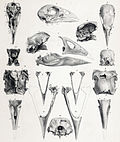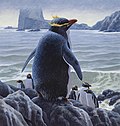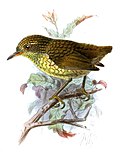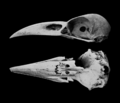Top Qs
Timeline
Chat
Perspective
List of New Zealand species extinct in the Holocene
From Wikipedia, the free encyclopedia
Remove ads
This is a list of New Zealand species extinct in the Holocene that covers extinctions from the Holocene epoch, a geologic epoch that began about 11,650 years Before Present (about 9700 BCE)[a] and continues to the present day.[1] This epoch equates with the latter third of the Haweran Stage of the Wanganui epoch in the New Zealand geologic time scale.


The North Island and South Island are the two largest islands of New Zealand. Stewart Island is the largest of the smaller islands. New Zealand proper also includes outlying islands such as the Chatham Islands, Kermadec Islands, and New Zealand Subantarctic Islands. Only New Zealand proper is represented on this list, not the Realm of New Zealand. For extinctions in the Cook Islands, Niue, or Tokelau, see the List of Oceanian animals extinct in the Holocene.
The islands of East Polynesia (including New Zealand, Hawaii, and Easter Island) were among the last habitable places on Earth colonised by humans.[2][3] The first settlers of New Zealand migrated from Polynesia and became the Māori people.[4] According to archeological and genetic research, the ancestors of the Māori arrived in New Zealand no earlier than about 1280 CE, with at least the main settlement period between about 1320 and 1350,[5][4] consistent with evidence based on whakapapa (genealogical traditions).[6][7] No credible evidence exists of pre-Māori settlement of New Zealand.[4] In 1642, the Dutch navigator Abel Tasman became the first European explorer known to visit New Zealand.[8] In 1769, British explorer James Cook became the first European to map New Zealand and communicate with the Māori.[9][10] From the late 18th century, the country was regularly visited by explorers and other sailors, missionaries, traders and adventurers. In 1840, the Treaty of Waitangi annexed New Zealand into the British Empire.[11][12][13] As a result of the influx of settlers, the population of Pākehā (European New Zealanders) grew explosively from fewer than 1,000 in 1831 to 500,000 by 1881.[14]
Numerous species have disappeared from New Zealand as part of the ongoing Holocene extinction, driven by human activity. Human contact, first by Polynesians and later by Europeans, had a significant impact on the environment. The arrival of the Māori resulted in animal extinctions due to deforestation[3] and hunting.[15] The Māori also brought two species of land mammals, Polynesian rats (Rattus exulans) and kurī, a breed of domestic dog (Canis lupus familiaris).[3][16] In pre-human times, bats were the only land mammals found in New Zealand.[17] Polynesian rats definitely contributed to extinctions,[3] and kurī might have contributed as well.[18][19] Like the Māori settlers centuries earlier, the European settlers hunted native animals and engaged in habitat destruction. They also introduced numerous invasive species.[20] A few examples are black rats (Rattus rattus) and brown rats (Rattus norvegicus),[21] domestic cats (Felis catus),[22] stoats (Mustela erminea),[23] and common brushtail possums (Trichosurus vulpecula).[24]
This list of extinct species only includes the indigenous biota of New Zealand, not domestic animals like the kurī.
Remove ads
Mammals (class Mammalia)
Bats (order Chiroptera)
New Zealand short-tailed bats (family Mystacinidae)
Possibly extinct
Carnivorans (order Carnivora)
Eared seals (family Otariidae)
Earless seals (family Phocidae)
Locally extinct
Remove ads
Birds (class Aves)
Summarize
Perspective
Moa (order Dinornithiformes)
Giant moa (family Dinornithidae)
Lesser moa (family Emeidae)
Upland moa (family Megalapterygidae)
Kiwis (order Apterygiformes)
Kiwis (family Apterygidae)
Landfowl (order Galliformes)
Megapodes (family Megapodidae)
Pheasants and allies (family Phasianidae)
Waterfowl (order Anseriformes)
Ducks, geese, and swans (family Anatidae)
Owlet-nightjars (order Aegotheliformes)
Owlet-nightjars (family Aegothelidae)
Pigeons and doves (order Columbiformes)
Pigeons and doves (family Columbidae)
Rails and cranes (order Gruiformes)
Adzebills (family Aptornithidae)
Rails (family Rallidae)
Shorebirds (order Charadriiformes)
Sandpipers (family Scolopacidae)
Albatrosses and petrels (order Procellariiformes)
Petrels and shearwaters (family Procellariidae)
Penguins (order Sphenisciformes)
Penguins (family Spheniscidae)
Boobies, cormorants, and allies (order Suliformes)
Cormorants and shags (family Phalacrocoracidae)
Pelicans, herons, and ibises (order Pelecaniformes)
Herons (family Ardeidae)
Hawks and relatives (order Accipitriformes)
Hawks, eagles, kites, harriers and Old World vultures (family Accipitridae)
Owls (order Strigiformes)
True owls (family Strigidae)
Parrots (order Psittaciformes)
Kea and kākā (family Nestoridae)
Old World parrots (family Psittaculidae)
New Zealand parrots (family Strigopidae)
Extinct in the wild
Perching birds (order Passeriformes)
New Zealand wrens (family Acanthisittidae)
Honeyeaters (family Meliphagidae)
Old World orioles (family Oriolidae)
Crows and relatives (family Corvidae)
New Zealand wattlebirds (family Callaeidae)
Possibly extinct, New Zealand wattlebirds (family Callaeidae)
Grassbirds and allies (family Locustellidae)
Australasian robins (family Petroicidae)
Extinct in the wild
Remove ads
Reptiles (class Reptilia)
Squamates (order Squamata)[e]
Skinks (family Scincidae)
Amphibians (class Amphibia)
Frogs (order Anura)
New Zealand primitive frogs (family Leiopelmatidae)
Remove ads
Ray-finned fish (class Actinopterygii)
Smelts (order Osmeriformes)
Australia-New Zealand smelts and graylings (family Retropinnidae)
Remove ads
Insects (class Insecta)
Beetles (order Coleoptera)
Ground beetles (family Carabidae)
Weevils (family Curculionidae)
Bark lice, book lice, and parasitic lice (order Psocodea)
Bird chewing lice (family Philopteridae)
Remove ads
Clitellates (class Clitellata)
Order Opisthopora
Family Megascolecidae
Plants (kingdom Plantae)
Order Brassicales
Mustard and crucifer family (family Brassicaceae)
Order Santalales
Showy mistletoes (family Loranthaceae)
Order Caryophyllales
Pink and carnation family (family Caryophyllaceae)
Order Gentianales
Family Loganiaceae
Order Boraginales
Borage and forget-me-not family (family Boraginaceae)
Remove ads
See also
- List of Australia-New Guinea species extinct in the Holocene
- List of Hawaiian animals extinct in the Holocene
- List of Oceanian animals extinct in the Holocene
- Holocene extinction
- Lists of extinct animals
- List of extinct bird species since 1500
- List of Late Quaternary prehistoric bird species
- New Zealand Threat Classification System
- New Zealand geologic time scale
Notes
- The extinct gecko Gigarcanum delcourti is known only from a single specimen of unknown provenance. It was previously considered a member of the New Zealand endemic genus Hoplodactylus, but DNA evidence from the specimen suggests that it originates from New Caledonia.[115]
Remove ads
References
Further reading
External links
Wikiwand - on
Seamless Wikipedia browsing. On steroids.
Remove ads


















































